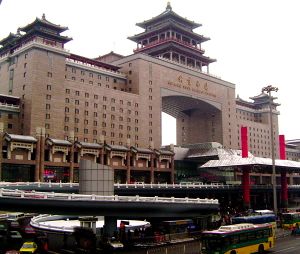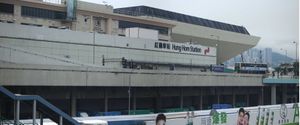Jingjiu Railway
Jingjiu Railway (also known as Beijing-Kowloon Railway, Beijing-Kowloon Line; Simplified Chinese: 京九铁路 or 京九线; Traditional Chinese: 京九鐵路 or 京九線) is a railway in the People's Republic of China connecting Beijing West Station in Beijing to Hung Hom Station (Kowloon Station) in Kowloon in the special administrative region of Hong Kong.
It is a dual-track railway. Construction began in February 1993. It was opened in 1996, connecting Beijing and Kowloon through Tianjin, Hebei, Shandong, Henan, Anhui, Hubei, Jiangsi and Guangdong, with a length of 2397 kilometres. It has 790 bridges and 160 tunnels. The Jiujiang Yangtze River Bridge, at a length of 7,679 metres, is the longest across the Yangtze River. Located between Jinghu Railway (Beijing-Shanghai) and Jingguang Railway (Beijing-Guangzhou), it was built to alleviate the congested Jingguang Railway, and to foster development in the areas to the east of Jingguang Railway.
The idea had been proposed for a long time, and some of the sections, such as the Jiujiang Yangtze River Bridge, were built before construction of the whole line official began. Some were converted from existing sections, such as between Jiujiang and Nanchang, and Fouyang and Shangqiu.
It share the same route with the Guangmeishan Railway (Guangzhou-Meizhou-Shantou Railway) between Longchuan and Dongguan. It joins the Guangshen Railway (Guangzhou-Shenzhen Railway, formerly the Chinese Section of the Kowloon-Canton Railway) at Dongguan, and follows the same route. Within Hong Kong, it shares the same pair of tracks with the KCR East Rail (formerly British Section of the Kowloon-Canton Railway).
Beijing-Kowloon Through Train services (京九直通車) are currently provided on the Jingguang Railway and Guangshen Railway, instead of the Jingjiu Railway. Passengers are required to go through customs and immigration checks for the cross-border service.
Stations and distance
|
|


